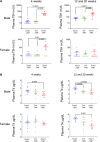Foxe1 Deletion in the Adult Mouse Is Associated With Increased Thyroidal Mast Cells and Hypothyroidism
- PMID: 36156081
- PMCID: PMC9618408
- DOI: 10.1210/endocr/bqac158
Foxe1 Deletion in the Adult Mouse Is Associated With Increased Thyroidal Mast Cells and Hypothyroidism
Abstract
Context: Foxe1 is a key thyroid developmental transcription factor. Germline deletion results in athyreosis and congenital hypothyroidism. Some data suggest an ongoing role for maintaining thyroid differentiation.
Objective: We created a mouse model to directly examine the role of Foxe1 in the adult thyroid.
Methods: A model of tamoxifen-inducible Cre-mediated ubiquitous deletion of Foxe1 was generated in mice of C57BL/6J background (Foxe1flox/flox/Cre-TAM). Tamoxifen or vehicle was administered to Foxe1flox/flox/Cre mice aged 6-8 weeks. Blood was collected at 4, 12, and 20 weeks, and tissues after 12 or 20 weeks for molecular and histological analyses. Plasma total thyroxine (T4), triiodothyronine, and thyrotropin (TSH) were measured. Transcriptomics was performed using microarray or RNA-seq and validated by reverse transcription quantitative polymerase chain reaction.
Results: Foxe1 was decreased by approximately 80% in Foxe1flox/flox/Cre-TAM mice and confirmed by immunohistochemistry. Foxe1 deletion was associated with abnormal follicular architecture and smaller follicle size at 12 and 20 weeks. Plasma TSH was elevated in Foxe1flox/flox/Cre-TAM mice as early as 4 weeks and T4 was lower in pooled samples from 12 and 20 weeks. Foxe1 deletion was also associated with an increase in thyroidal mast cells. Transcriptomic analyses found decreased Tpo and Tg and upregulated mast cell markers Mcpt4 and Ctsg in Foxe1flox/flox/Cre-TAM mice.
Conclusion: Foxe1 deletion in adult mice was associated with disruption in thyroid follicular architecture accompanied by biochemical hypothyroidism, confirming its role in maintenance of thyroid differentiation. An unanticipated finding was an increase in thyroidal mast cells. These data suggest a possible explanation for previous human genetic studies associating alleles in/near FOXE1 with hypothyroidism and/or autoimmune thyroiditis.
Keywords: FOXE1; autoimmune thyroiditis; hypothyroidism; mast cells.
© The Author(s) 2022. Published by Oxford University Press on behalf of the Endocrine Society.
Figures








References
-
- Fernandez LP, Lopez-Marquez A, Santisteban P. Thyroid transcription factors in development, differentiation and disease. Nat Rev Endocrinol. 2015;11(1):29–42. - PubMed
-
- Eichberger T, Regl G, Ikram MS, et al. . Foxe1, a new transcriptional target of GLI2 is expressed in human epidermis and basal cell carcinoma. J Invest Dermatol. 2004;122(5):1180–1187. - PubMed
-
- Sequeira M, Al-Khafaji F, Park S, et al. . Production and application of polyclonal antibody to human thyroid transcription factor 2 reveals thyroid transcription factor 2 protein expression in adult thyroid and hair follicles and prepubertal testis. Thyroid. 2003;13(10):927–932. - PubMed
-
- Clifton-Bligh RJ, Wentworth JM, Heinz P, et al. . Mutation of the gene encoding human TTF-2 associated with thyroid agenesis, cleft palate and choanal atresia. Nat Genet. 1998;19(4):399–401. - PubMed
Publication types
MeSH terms
Substances
Grants and funding
LinkOut - more resources
Full Text Sources
Molecular Biology Databases
Miscellaneous

